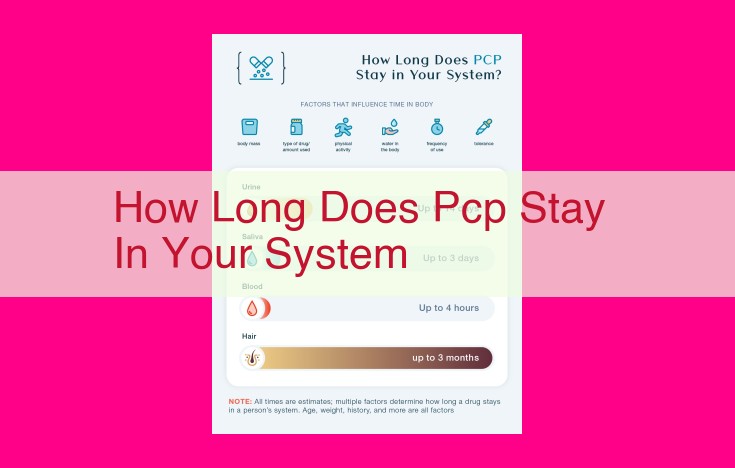Pcp Detection: Factors Influencing Duration And Drug Testing Methods

The duration of PCP in an individual’s system is influenced by factors such as metabolism rate, weight, and liver/kidney function. Drug testing methods, including urine, blood, and hair follicle tests, vary in their detection capabilities and limitations.
Understanding Drug Detection: External Factors
In the realm of drug testing, accuracy is paramount. External factors can significantly influence the detection of drug use, potentially affecting the outcomes of substance abuse evaluations. Understanding these variables is crucial for interpreting test results and ensuring fair and reliable assessments.
Metabolism Rate
- The speed at which your body metabolizes drugs varies from person to person.
- A fast metabolism can eliminate drugs from the body more quickly, potentially making them harder to detect.
- Conversely, a slow metabolism may result in longer drug retention, leading to increased detection times.
Weight
- Body weight plays a role in drug distribution and elimination.
- Drugs tend to distribute throughout body tissues and fluids.
- Individuals with higher body mass may have larger volumes of fluids and tissues, potentially diluting drug concentrations and reducing detectability.
Liver and Kidney Function
- The liver metabolizes drugs, while the kidneys excrete them from the body.
- Impaired liver or kidney function can significantly affect drug clearance, influencing detection timelines.
- For example, liver damage may slow down drug metabolism, leading to prolonged drug detection.
It’s important to note that these external factors interact in complex ways, making it challenging to accurately predict drug detection outcomes. However, understanding these variables can provide valuable insights and inform the interpretation of drug test results.
Drug Testing Methods and their Applications
When it comes to drug testing, there are multiple methods available, each with its own advantages and disadvantages. Understanding these methods is crucial for individuals who may need to undergo drug testing or for employers seeking to establish effective drug-free workplace policies.
1. Urine Drug Tests:
Urine drug tests are the most common type of drug test, primarily due to their convenience and cost-effectiveness. These tests detect drug metabolites present in the urine, which can indicate recent drug use. Urine drug tests have a detection window of several days, making them suitable for detecting recent drug use. However, they are less sensitive than other methods and can be affected by factors such as dilution, adulteration, or certain medications.
2. Blood Tests:
Blood drug tests are considered the most accurate method as they detect the actual presence of drugs in the bloodstream. They provide a shorter detection window compared to urine tests, typically within hours or days. Blood tests are often used in emergency situations, such as for suspected drug overdose, or when rapid results are required. However, they are more invasive and expensive than urine tests.
3. Hair Follicle Tests:
Hair follicle drug tests are considered the most comprehensive method as they can detect drug use over a longer period, typically months to years. Drugs are incorporated into the hair shaft as it grows, providing a historical record of drug use. Hair follicle tests are not affected by recent activities like exercise or hydration, making them difficult to tamper with. However, they are also the most expensive and time-consuming method to perform.
Understanding these drug testing methods empowers individuals with the knowledge to make informed decisions regarding their substance use. For employers, it aids in establishing effective drug-free workplace policies that are fair and accurate. By choosing the appropriate testing method based on the specific requirements and circumstances, individuals and organizations can ensure the integrity and reliability of drug testing results.
Drug Regulations and Enforcement: Ensuring Safety
- Introduce key organizations involved in drug regulation, such as NIDA, SAMHSA, and ASAM.
- Explain their roles and responsibilities in setting drug policies, conducting research, and providing support for substance abuse prevention and treatment.
Drug Regulations and Enforcement: Ensuring Safety
The intricate tapestry of drug regulations and enforcement plays a pivotal role in safeguarding public health and ensuring safety. At the forefront of this endeavor are esteemed organizations like the National Institute on Drug Abuse (NIDA), the Substance Abuse and Mental Health Services Administration (SAMHSA), and the American Society of Addiction Medicine (ASAM).
Each organization holds a unique but collaborative role in the fight against illicit drug use. NIDA, a cornerstone of scientific research, relentlessly pursues cutting-edge knowledge on the effects of drug abuse, its consequences, and effective treatment modalities. SAMHSA, with its unparalleled expertise, provides vital support and guidance to individuals struggling with substance use disorders, offering a lifeline of hope and recovery.
ASAM, representing the collective voice of addiction medicine specialists, serves as an advocate for evidence-based treatment practices. Its guidelines and standards help healthcare providers deliver the highest quality of care, empowering patients to break free from the clutches of addiction.
Together, these organizations forge an unyielding alliance against the scourge of drug abuse. They set forth rigorous policies that govern drug classification, medical prescribing practices, and law enforcement strategies. Through collaborative efforts, they ensure that drugs are used responsibly and illicit substances are kept out of the hands of those who may succumb to their dangers.
By investing in research, providing accessible treatment options, and enforcing stringent regulations, these organizations work tirelessly to protect communities from the devastating consequences of drug abuse. Their unwavering commitment empowers individuals to live healthier, more fulfilling lives while safeguarding the well-being of our society.